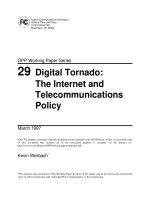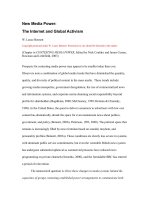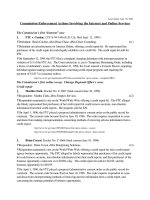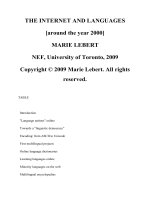infomation technology the internet and you chapter 05
Bạn đang xem bản rút gọn của tài liệu. Xem và tải ngay bản đầy đủ của tài liệu tại đây (3.11 MB, 36 trang )
Chapter
5
The System Unit
Chapter 5
© 2017 by McGraw-Hill Education. This proprietary material solely for authorized instructor use. Not authorized for sale or distribution in any manner. This document may not be copied, scanned, duplicated, forwarded, distributed, or
posted on a website, in whole or part.
Learning Objectives
Computing Essentals 2017
1. Differentiate between the five basic types of system units.
2. Describe system boards, including sockets, slots, and bus lines.
3. Recognize different microprocessors, including microprocessor chips and
specialty processors.
4. Compare different types of computer memory including RAM, ROM, and
flash memory.
5. Explain expansion slots and cards.
6. Describe bus lines, bus widths, and expansion buses.
7. Describe ports, including standard and specialized ports.
8. Identify power supplies for desktop, laptop, tablet, and mobile devices.
9. Explain how a computer can represent numbers and encode characters
electronically.
2
© 2017 by McGraw-Hill Education. This proprietary material solely for authorized instructor use. Not authorized for sale or distribution in any manner. This document may not be copied, scanned, duplicated, forwarded, distributed, or
posted on a website, in whole or part.
Introduction
Computing Essentals 2017
Speed, capacity, and flexibility determine
the power of personal computers.
Knowledge of a computer’s power allows
you to make good buying decisions and to
determine if your current system will run
new applications.
Competent end users need to understand
the functionality of the basic components of
the system unit
© 2017 by McGraw-Hill Education. This proprietary material solely for authorized instructor use. Not authorized for sale or distribution in any manner. This document may not be copied, scanned, duplicated, forwarded, distributed, or
posted on a website, in whole or part.
System Unit
Computing Essentals 2017
System Chassis
Container that houses most of the electronic
components that make up a computer system
System Unit
Contains system’s electronic components and
selected secondary storage devices
4
© 2017 by McGraw-Hill Education. This proprietary material solely for authorized instructor use. Not authorized for sale or distribution in any manner. This document may not be copied, scanned, duplicated, forwarded, distributed, or
posted on a website, in whole or part.
System Unit Types
1. Desktops
System unit is in a separate case
Computing Essentals 2017
Tower Units
All-in-Ones
All components including monitor
2. Laptops
Portable and much smaller
Ultrabooks – laptop and tablet in one
Gaming – high end graphics
© 2017 by McGraw-Hill Education. This proprietary material solely for authorized instructor use. Not authorized for sale or distribution in any manner. This document may not be copied, scanned, duplicated, forwarded, distributed, or
posted on a website, in whole or part.
System Unit Types cont.
3. Tablets
Mini tablet
Computing Essentals 2017
4. Smartphone
Most popular device – handheld computer
Extend the capabilities of cell phones
5. Wearables
Contain embedded computers
© 2017 by McGraw-Hill Education. This proprietary material solely for authorized instructor use. Not authorized for sale or distribution in any manner. This document may not be copied, scanned, duplicated, forwarded, distributed, or
posted on a website, in whole or part.
Components
Although all
Computing Essentals 2017
devices come in
many shapes and
sizes they have
similarities such as
System boards
Microprocessors
Memory
© 2017 by McGraw-Hill Education. This proprietary material solely for authorized instructor use. Not authorized for sale or distribution in any manner. This document may not be copied, scanned, duplicated, forwarded, distributed, or
posted on a website, in whole or part.
Computing Essentals 2017
System Board
System board or main board or
motherboard controls
communication for the entire
computer system
All components and devices
connect to the system board
Data path and traffic monitor
Allows various components to
communication efficiently with one
another
© 2017 by McGraw-Hill Education. This proprietary material solely for authorized instructor use. Not authorized for sale or distribution in any manner. This document may not be copied, scanned, duplicated, forwarded, distributed, or
posted on a website, in whole or part.
Sockets and Chips
Computing Essentals 2017
The system board contains a
variety of electronic
components
Sockets – the connection
point for chips
Chips
Tiny circuit boards etched onto
squares of silicon
Also called silicon chip,
semiconductor, or integrated circuit
Mounted on chip carriers
© 2017 by McGraw-Hill Education. This proprietary material solely for authorized instructor use. Not authorized for sale or distribution in any manner. This document may not be copied, scanned, duplicated, forwarded, distributed, or
posted on a website, in whole or part.
Slots and Bus Lines
Additional system board components:
Slots
Provide a connection point for specialized cards or circuit boards
Provide expansion capabilities for the computer
Computing Essentals 2017
Bus lines
Connecting lines that provide pathways to support communication
among electronic components
© 2017 by McGraw-Hill Education. This proprietary material solely for authorized instructor use. Not authorized for sale or distribution in any manner. This document may not be copied, scanned, duplicated, forwarded, distributed, or
posted on a website, in whole or part.
Microprocessor
Central Processing Unit (CPU) or Processor
Computing Essentals 2017
Contained on a single chip call a Microprocessor
Brains of the computer
Two Basic Components of the CPU
Control unit
Tells the computer system how to carry out a
program’s instruction
Arithmetic-logic unit (ALU)
Performs arithmetic and logical operations
11
© 2017 by McGraw-Hill Education. This proprietary material solely for authorized instructor use. Not authorized for sale or distribution in any manner. This document may not be copied, scanned, duplicated, forwarded, distributed, or
posted on a website, in whole or part.
Microprocessor Chips
Chip capacities are expressed in word size
Word is the number of bits that can be processed at
one time: 16, 32 or 64
Computing Essentals 2017
Clock Speed
Processing speed or the number of times the CPU
fetches and processes data or instructions in a second
© 2017 by McGraw-Hill Education. This proprietary material solely for authorized instructor use. Not authorized for sale or distribution in any manner. This document may not be copied, scanned, duplicated, forwarded, distributed, or
posted on a website, in whole or part.
Multicore Chips
Multicore Processors
Two or more separate and independent CPUs within a system unit
Quad-core supports 4 core processes
Computing Essentals 2017
Parallel Processing
Computer’s ability to divided tasks into parts that can be
distributed across each core
Windows 8 and Mac OS X support parallel processing
© 2017 by McGraw-Hill Education. This proprietary material solely for authorized instructor use. Not authorized for sale or distribution in any manner. This document may not be copied, scanned, duplicated, forwarded, distributed, or
posted on a website, in whole or part.
Specialty Processors
Coprocessors
Computing Essentals 2017
Designed to improve specific computing operations
Graphics Processing Unit (GPU) / Graphics coprocessors
Designed to handle a variety of specialized tasks
3D images
Encrypting data
Standard features in gaming computers
© 2017 by McGraw-Hill Education. This proprietary material solely for authorized instructor use. Not authorized for sale or distribution in any manner. This document may not be copied, scanned, duplicated, forwarded, distributed, or
posted on a website, in whole or part.
Memory
Holding area for data, instructions, and
Computing Essentals 2017
information
Contained on chips connected to the system board
Three well-known types of memory chips:
RAM
Random Access Memory
ROM
Read Only Memory
Flash Memory
© 2017 by McGraw-Hill Education. This proprietary material solely for authorized instructor use. Not authorized for sale or distribution in any manner. This document may not be copied, scanned, duplicated, forwarded, distributed, or
posted on a website, in whole or part.
RAM
Random Access Memory (RAM)
chips hold programs and data that
the CPU is presently processing
Volatile or temporary – contents are
Computing Essentals 2017
lost when computer is powered off
Cache memory – temporary, highspeed holding area between the
memory and CPU
Additional RAM can be added using
an expansion module called a DIMM
(Dual in-line memory module)
© 2017 by McGraw-Hill Education. This proprietary material solely for authorized instructor use. Not authorized for sale or distribution in any manner. This document may not be copied, scanned, duplicated, forwarded, distributed, or
posted on a website, in whole or part.
RAM continued
Virtual Memory
Dividing a program between memory and storage
enabling the system to run very large programs
Computing Essentals 2017
Memory is expressed in bytes
© 2017 by McGraw-Hill Education. This proprietary material solely for authorized instructor use. Not authorized for sale or distribution in any manner. This document may not be copied, scanned, duplicated, forwarded, distributed, or
posted on a website, in whole or part.
ROM
Read-only memory (ROM)
Information stored by the manufacturer
Non-volatile and cannot be changed
Computing Essentals 2017
CPU can read, or retrieve data and programs in
ROM but the computer cannot change ROM
Contain special instructions
Start the computer
Access memory
Handle keyboard input
© 2017 by McGraw-Hill Education. This proprietary material solely for authorized instructor use. Not authorized for sale or distribution in any manner. This document may not be copied, scanned, duplicated, forwarded, distributed, or
posted on a website, in whole or part.
Flash Memory
Flash memory combines of the features of:
Computing Essentals 2017
RAM, it can be updated
ROM, it is non-volatile
Contains startup information
BIOS (basic input/output system)
Amount of RAM
Type of keyboard, mouse, and secondary storage devices
connected
Many ROM chips are being replaced by flash memory
© 2017 by McGraw-Hill Education. This proprietary material solely for authorized instructor use. Not authorized for sale or distribution in any manner. This document may not be copied, scanned, duplicated, forwarded, distributed, or
posted on a website, in whole or part.
Computing Essentals 2017
Expansion Slots and Cards
Expands your system’s
capabilities
Graphics cards for high quality
3D graphics
Network interface cards (NIC)
connect devices to networks via
cables
Wireless network cards connect
devices to networks without
cables
SD cards
Expansion cards for mobile
devices
© 2017 by McGraw-Hill Education. This proprietary material solely for authorized instructor use. Not authorized for sale or distribution in any manner. This document may not be copied, scanned, duplicated, forwarded, distributed, or
posted on a website, in whole or part.
Bus Lines / Bus
Computing Essentals 2017
Connect parts of the CPU to each other and various
other components on the system board
Pathway for bits representing data and instructions
Bus width
Number of bits that can travel simultaneously down a bus
Architecture and design are tied to the speed and
power for the computer
Two basic categories of buses
System bus – connects CPU to memory
Expansion bus – connects CPU to other components
© 2017 by McGraw-Hill Education. This proprietary material solely for authorized instructor use. Not authorized for sale or distribution in any manner. This document may not be copied, scanned, duplicated, forwarded, distributed, or
posted on a website, in whole or part.
Expansion Buses
Principle types:
Universal Serial Bus (USB)
Connects external USB devices onto the USB bus
Computing Essentals 2017
FireWire
Primarily used to connect audio and video equipment to the
system board
PCI Express (PCIe)
Single dedicated path for each connected device
© 2017 by McGraw-Hill Education. This proprietary material solely for authorized instructor use. Not authorized for sale or distribution in any manner. This document may not be copied, scanned, duplicated, forwarded, distributed, or
posted on a website, in whole or part.
Ports
Computing Essentals 2017
Socket for connecting external
devices to the system unit
Ports connect directly
To the system board
To cards inserted into slots on
the system board
Two Types
Standard Ports
Specialized Ports
© 2017 by McGraw-Hill Education. This proprietary material solely for authorized instructor use. Not authorized for sale or distribution in any manner. This document may not be copied, scanned, duplicated, forwarded, distributed, or
posted on a website, in whole or part.
Standard Ports
USB
Keyboards, mice, printers,
storage devices
Computing Essentals 2017
Ethernet
High speed networking
HDMI – High Definition Multimedia Interface
High definition video and audio
Thunderbolt
Provides high-speed connections
Can connect up to 7 separate devices through 1 port
© 2017 by McGraw-Hill Education. This proprietary material solely for authorized instructor use. Not authorized for sale or distribution in any manner. This document may not be copied, scanned, duplicated, forwarded, distributed, or
posted on a website, in whole or part.
Specialized Ports
External Serial Advanced Technology Attachment (eSATA)
High-speed connection for external secondary storage
Musical Instrument Digital Interface (MIDI)
Computing Essentals 2017
Connect musical instruments
Mini DisplayPort (MiniDP or mDP)
Connection to large monitors
VGA & DVI
Connections to analog and digital monitors
FireWire
High-speed connections to FireWire devices
© 2017 by McGraw-Hill Education. This proprietary material solely for authorized instructor use. Not authorized for sale or distribution in any manner. This document may not be copied, scanned, duplicated, forwarded, distributed, or
posted on a website, in whole or part.









